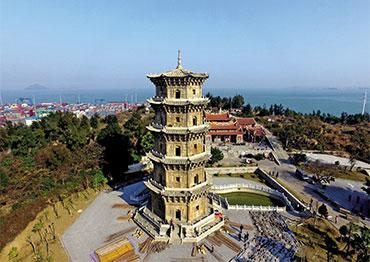As its reputation faded, Quanzhou started to regain world recognition in 1990 and 1991, when UNESCO sent a team to revisit the Maritime Silk Road sponsored by the King of Oman. The delegation spent six days in Quanzhou.
Dr Doudou Diene, the international team leader of the UNESCO Maritime Route Expedition, who visited Quanzhou in 1991, said he was impressed by the Statue of Mani in Cao’an Temple, a temple of Manichaeism, which originated in ancient Persia. Little remains of it today. The rare Manichaean statue in Quanzhou was adopted as the emblem of the World Manichaean Society.
To help arrange visits and liaise with international experts, Quanzhou set up a special office. Chen Bingkun, then director of the Quanzhou Bureau of Cultural Heritage, was deputy director. He told NewsChina they took extreme care when arranging the visits, even when one delegation arrived on the first day of the Chinese New Year. It rained a lot that year, but local people were very welcoming.
Throughout the 1990s, research on the Maritime Silk Road flourished in Quanzhou. In May 1999, Richard Engelhardt, UNESCO Regional Advisor for Culture in Asia and the Pacific, suggested that Quanzhou could apply for World Heritage status. The many scattered ancient sites could be bundled together to make a complete application.
China had only been party to the World Heritage Convention since 1985, so even in the late 1990s, local authorities lacked experience in the application process. They started in April 2001, Chen said, who added that it was a very long journey.
In 2018, Quanzhou delivered its initial proposal for the application titled “Historic Monuments and Sites of Ancient Quanzhou (Zayton),” featuring 16 component sites. After it was presented to the World Heritage Committee for deliberation, it was deferred by the committee at the 42nd session in Bahrain that year.
China was told it needed supplemental material before resubmitting its application. The International Council of Monuments and Sites, the advisory body involved in the deliberations, believed the relationship of some sites and maritime trade routes was not well illustrated.
In 2020, as Quanzhou sought its second attempt for World Heritage status, it changed its theme to the current one: “Quanzhou: Emporium of the World in Song-Yuan China,” and added six more ancient sites.
“A major adjustment has been made to the declared project from the technical level, and the theme is much clearer and complete,” said Zhang Lei, head of the World Cultural Heritage Department of the State Administration of Cultural Heritage.
Most of the newly added heritage sites are archaeological sites, including new discoveries since 2018. The Southern Clan Office was an administrative agency established for Song Dynasty kinsmen who relocated to Quanzhou in 1130 and after.
Others include ancient kiln sites for porcelain production – the Dehua Kilns date from the Song and Yuan, while the Cizao Kilns are much older, dating from 420 to 589. Xiacaopu Iron Production Site in Qingyang Village in Anxi is a Song Dynasty metallurgical producing area, indicating that Quanzhou was more than just an area for trade and transport.
The sites were not originally included, Chen said, because they are located in rural regions, and the kilns are nearly 100 kilometers away from central Quanzhou and were difficult to access.
“But now, the facilities have been enhanced and the environment improved, and it’s quite different from over a decade ago.”

 Old Version
Old Version

